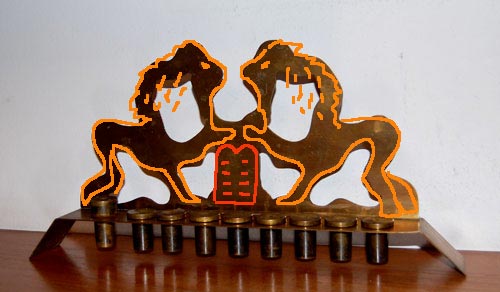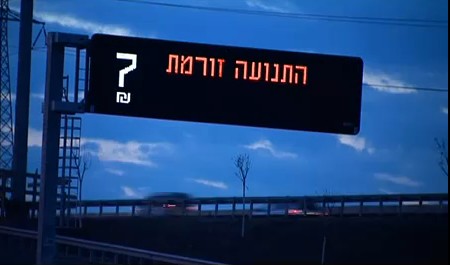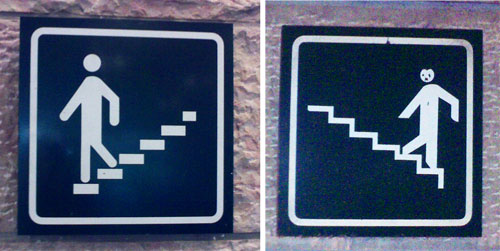Here is a brass Hanukkiah, a 9-candle Hanukkah lamp, that we got in the seventies. It was made by Maskit, the pioneering maker of folklore-inspired clothing and art items in Israel’s early years.

It can accept candles or oil, and is as lovely as it is functional. However, what gets it a place in my design blog is the seemingly abstract pattern on its back plane. We’ve had it in our living room for some years before it suddenly hit me that this was not just an abstract shape. Do you see what it is?
What gave it away, for me, was the butts of the two lions, sticking up in the air. Suddenly I realized that I was seeing a traditional decorative pattern familiar in Judaica art, especially on Hanukkah lamps and on decorations on the Torah Ark in a synagogue: the two lions guarding the tablets of the law. You can see them in the two examples below:


The overlay below will help you see it, and then it’s obvious; but what I really admire in this piece is how the artist managed to capture so exquisitely well, in just a few lines, the anatomy of the two lions. Good job!

The 65 km trip from Jerusalem to Tel Aviv used to take two days on a donkey from biblical days to the 20th century. Then it went down to 3 hours by car in the fifties, then 2 hours, and finally below 60 minutes on the Highway 1 six-lane freeway. Then people bought more cars, and we’re back to 2 hours in the rush hour…
Enter the Fast Lane, which opened last week. This is an added lane on the last 13 km before Tel Aviv. It is open for free to car pools and public transport, and has a Park-and-Ride facility to boot. And all this is funded by tolls collected from the rest of us if we choose to use it.
But what happens in the rush hour, when everyone might want to use the new lane, bringing it to a standstill?
This is where the ingenuity shows. The toll is variable: it is posted on a large electronic sign ahead of the on ramp. When demand is low, it’s a reasonable 7 Shekels (about $2). When the lane fills up, it grows gradually up to a whopping 75 Shekels – more than enough to deter most drivers. The parameter defining the price is the speed of traffic flow in the fast lane itself, which is measured automatically at any moment; by using this to set the cost, a minimum speed of 70 kph is guaranteed by the company running the lane.
Here is the sign – in addition to a 7 Shekel price, it informs that traffic ahead is flowing (hence the low toll).

To an engineer, this is an obvious application of negative feedback to control a system; but it is rare to see such an elegant application of this concept where something as unpredictable as traffic congestion is controlled by a feedback loop incorporating automatic sensors and the trade-off between the factors of human impatience and human parsimony…
I was in a shopping center and I saw these two signs on different floors, pointing out the emergency stairs’ entrance.
Now, the sign on the left is well drawn and clear – the guy is purposefully descending the stairs. But the sign on the right has something very wrong…

It’s a bit hard to say exactly what it is with this poor chap on the sign… does he have a broken arm? A bad knee? Is he climbing the stairs or descending them? Perhaps the best description is that he’s drunk and wobbling about on the stairs.
Oh well…
I wrote before about the impact of a cheerful nature on the customer service experience. Well – here is another example.
We were visiting the Museum für Naturkunde in Berlin (recommended! A 200 year old Natural History museum, like the one at Dublin I wrote about once, but artfully modernized and with some really big dinosaurs thrown in!) It being in winter, we obviously headed first for the cloakroom where we dumped a few kilograms of insulation; and we started on the task of deciphering a sign on the wall to figure the fee we’d have to pay.
At which point the young lady at the counter, perceiving our linguistic struggle, said to us in English: “It costs only a smile!” … and she proceeded to illustrate with a charming one of her own, invoking a return in kind.
What a lovely welcome!







